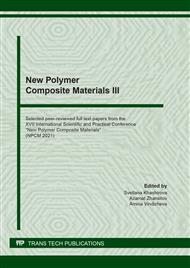p.125
p.132
p.137
p.144
p.150
p.158
p.164
p.172
p.179
Composite Material for the Manufacture of Plastic Sleepers
Abstract:
The composite materials intended for the manufacture of plastic sleepers were produced, which significantly differ from the materials widely used in railway transport of wooden and reinforced concrete sleepers. The coefficients of linear thermal expansion of the obtained materials are significantly lower. Polyvinyl chloride is used as a polymer binder, and the filler is a mixture of softwood flour with the mineral filler in the form of finely ground chalk. It was shown that by varying the content of the components of the composite, a change in its density is achieved by 19%, and the change in the value of the coefficient of linear thermal expansion depends on the temperature and relaxation of internal stresses in the samples, varying by 18.7 times – from 288.4·10-6 to 15.4·10-6 °C -1.
Info:
Periodical:
Pages:
150-157
Citation:
Online since:
September 2021
Price:
Сopyright:
© 2021 Trans Tech Publications Ltd. All Rights Reserved
Share:
Citation:


